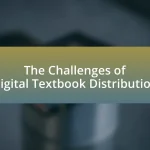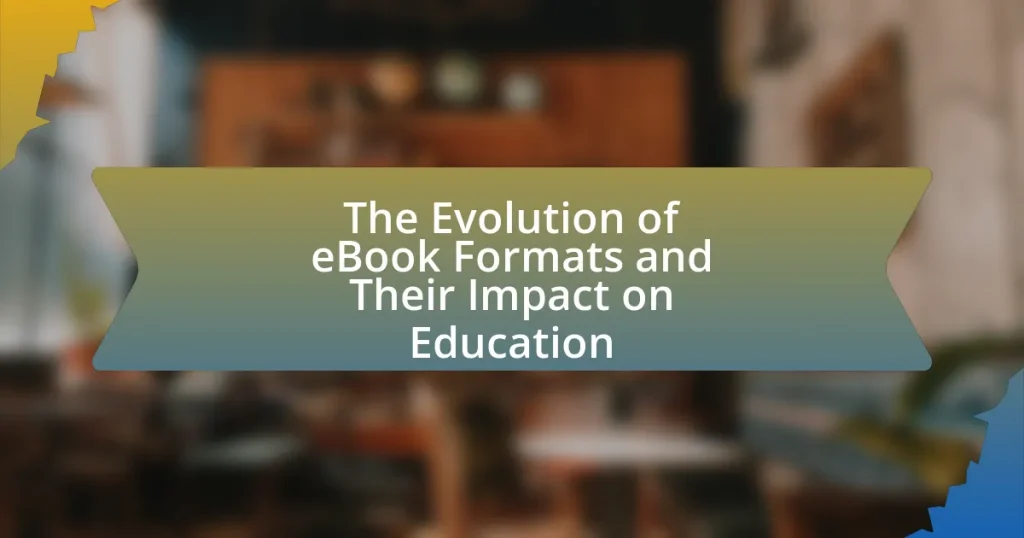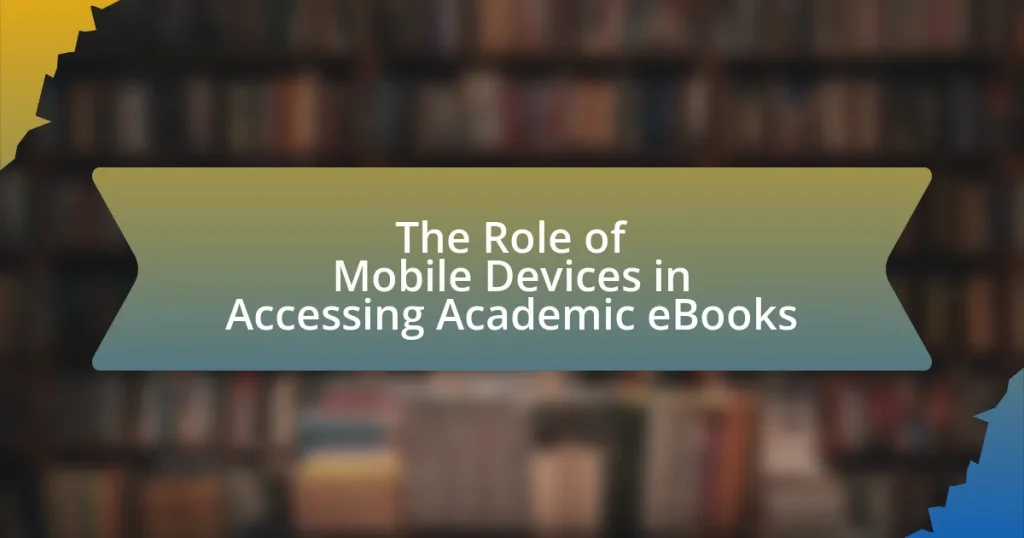The article examines the evolution of eBook formats, including EPUB, PDF, and MOBI, and their significant impact on education. It highlights how advancements in technology and user needs have shaped these formats, leading to increased interactivity and accessibility in educational materials. The discussion covers various eBook formats, their advantages and disadvantages, and the role of proprietary versus open formats. Additionally, it explores how mobile devices and digital publishing innovations are influencing the future of eBook formats, emphasizing their importance in enhancing personalized learning experiences and improving educational outcomes.
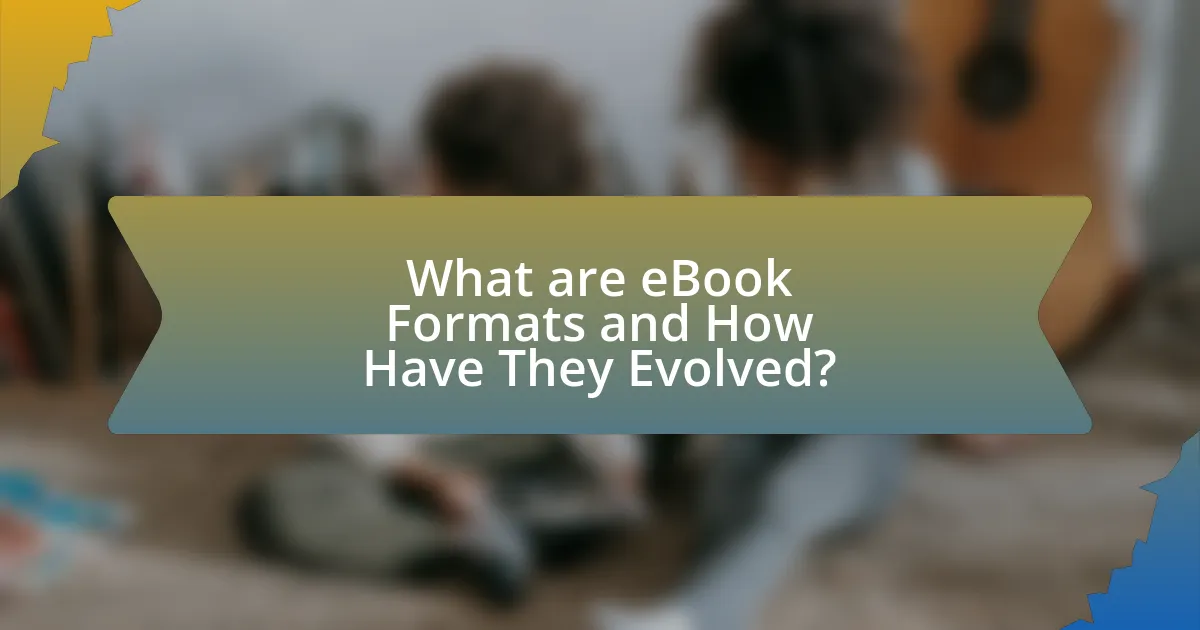
What are eBook Formats and How Have They Evolved?
eBook formats are digital file types designed for electronic reading, with the most common formats being EPUB, PDF, and MOBI. EPUB, introduced in 2007, allows for reflowable content, making it adaptable to various screen sizes, while PDF, developed in the early 1990s, preserves the layout of printed documents but lacks flexibility. MOBI, created for Amazon’s Kindle devices, supports features like annotations and bookmarks but is less widely used outside of that ecosystem.
The evolution of these formats has been driven by technological advancements and user needs; for instance, the rise of mobile devices has increased the demand for formats that support dynamic content and interactivity. As of 2023, the EPUB 3.2 standard includes support for multimedia and enhanced accessibility features, reflecting a shift towards more inclusive and engaging educational materials. This evolution has significantly impacted education by enabling more interactive and accessible learning resources, thus enhancing the overall learning experience.
What are the different types of eBook formats available?
The different types of eBook formats available include EPUB, MOBI, PDF, AZW, and HTML. EPUB is widely used for its reflowable content, making it adaptable to various screen sizes, while MOBI is primarily associated with Amazon Kindle devices. PDF maintains fixed formatting, making it suitable for documents that require precise layout. AZW is a proprietary format used by Kindle, offering features like DRM protection. HTML is often used for web-based eBooks, allowing for interactive content. These formats cater to diverse reading preferences and device compatibilities, influencing how educational materials are distributed and accessed.
How do proprietary formats differ from open formats?
Proprietary formats are file types controlled by specific companies, while open formats are publicly available and can be used by anyone without restrictions. Proprietary formats, such as Adobe’s PDF or Microsoft’s DOCX, often require specific software for access and may involve licensing fees, limiting user flexibility. In contrast, open formats like EPUB or HTML are designed to be universally accessible, promoting interoperability across different platforms and devices. The World Wide Web Consortium (W3C) supports open standards, emphasizing their role in fostering innovation and accessibility in digital content.
What are the advantages and disadvantages of popular eBook formats?
Popular eBook formats, such as EPUB, PDF, and MOBI, offer distinct advantages and disadvantages. EPUB is widely supported and allows for reflowable text, making it adaptable to various screen sizes, but it may not preserve complex layouts as effectively as PDF, which is ideal for fixed layouts but lacks flexibility on smaller devices. MOBI, primarily used by Amazon Kindle, supports features like annotations and bookmarks, yet it is less compatible with non-Amazon devices. Each format’s usability can significantly impact educational accessibility and user experience, highlighting the need for careful selection based on specific requirements.
How has technology influenced the evolution of eBook formats?
Technology has significantly influenced the evolution of eBook formats by enabling the development of diverse, interactive, and accessible digital reading experiences. The introduction of eReaders, such as Amazon’s Kindle in 2007, revolutionized how eBooks are consumed, leading to the adoption of formats like MOBI and EPUB that support features such as adjustable text size, embedded multimedia, and hyperlinks. Furthermore, advancements in cloud computing and mobile technology have facilitated the rise of platforms like Apple Books and Google Play Books, which allow seamless access to eBooks across multiple devices. According to a report by the International Digital Publishing Forum, the global eBook market was valued at approximately $18 billion in 2020, reflecting the growing demand for versatile eBook formats driven by technological innovations.
What role do advancements in digital publishing play in format development?
Advancements in digital publishing significantly influence format development by enabling the creation of more versatile and interactive eBook formats. These advancements, such as improved software tools and enhanced distribution platforms, allow for the integration of multimedia elements, adaptive layouts, and interactive features that cater to diverse learning styles. For instance, the introduction of EPUB 3 supports audio, video, and interactivity, which enhances the educational experience by making content more engaging and accessible. This evolution in format development is crucial for meeting the needs of modern learners and educators, as evidenced by the increasing adoption of interactive eBooks in educational settings, which has been shown to improve comprehension and retention rates.
How have mobile devices impacted eBook format evolution?
Mobile devices have significantly influenced the evolution of eBook formats by driving the demand for more flexible, user-friendly, and interactive reading experiences. The rise of smartphones and tablets has led to the development of formats like EPUB and MOBI, which support reflowable text and multimedia elements, enhancing accessibility and engagement. For instance, according to a report by the Pew Research Center, as of 2021, 85% of Americans own a smartphone, which has contributed to the increased consumption of digital content, including eBooks. This shift has prompted publishers to adapt their formats to include features such as adjustable font sizes, embedded audio, and video, catering to the preferences of mobile users.
What trends are shaping the future of eBook formats?
The future of eBook formats is being shaped by trends such as enhanced interactivity, integration of multimedia elements, and the rise of subscription-based models. Enhanced interactivity allows readers to engage with content through features like quizzes and annotations, which can improve comprehension and retention. The integration of multimedia elements, such as videos and audio, enriches the reading experience and caters to diverse learning styles. Additionally, subscription-based models, exemplified by services like Kindle Unlimited, are changing how readers access and consume eBooks, promoting a shift towards more flexible and affordable reading options. These trends are supported by data indicating that interactive eBooks can increase student engagement by up to 50%, highlighting their potential impact on education.
How is the rise of multimedia content changing eBook formats?
The rise of multimedia content is transforming eBook formats by integrating interactive elements such as videos, audio, and animations, enhancing user engagement and learning experiences. This shift allows eBooks to move beyond static text, making them more dynamic and appealing, particularly in educational contexts. For instance, research indicates that interactive eBooks can improve comprehension and retention rates among students, as they cater to various learning styles and preferences. The incorporation of multimedia features aligns with the increasing demand for digital learning tools that foster active participation and deeper understanding of the material.
What innovations are expected in eBook formats in the coming years?
Innovations expected in eBook formats in the coming years include enhanced interactivity, integration of multimedia elements, and improved accessibility features. These advancements aim to create a more engaging reading experience, allowing users to interact with content through quizzes, videos, and animations. For instance, the incorporation of augmented reality (AR) and virtual reality (VR) technologies is anticipated to provide immersive learning experiences, particularly in educational contexts. Additionally, eBooks are likely to adopt adaptive learning technologies that personalize content based on individual user preferences and learning styles, thereby enhancing educational outcomes. These trends are supported by ongoing research in digital learning environments, which emphasizes the importance of interactive and personalized content in improving student engagement and retention.
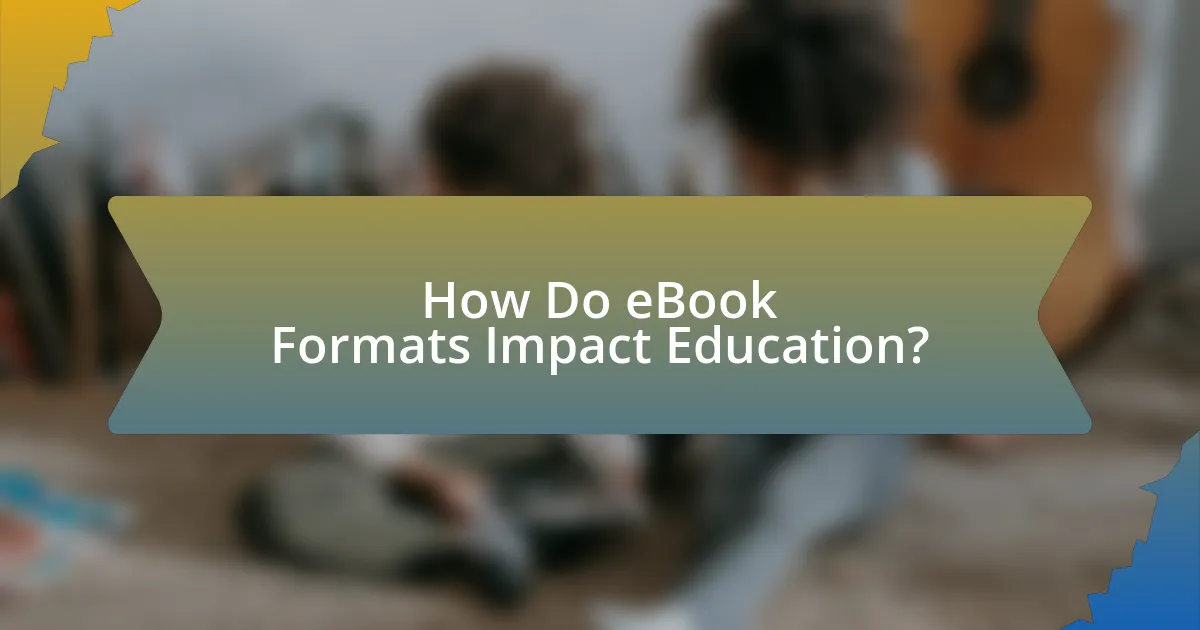
How Do eBook Formats Impact Education?
eBook formats significantly impact education by enhancing accessibility, interactivity, and personalization of learning materials. Various formats, such as EPUB and PDF, allow for features like adjustable text size, embedded multimedia, and hyperlinks, which cater to diverse learning styles and needs. Research indicates that students using interactive eBooks demonstrate improved engagement and retention rates compared to traditional textbooks, as evidenced by a study published in the Journal of Educational Technology & Society, which found that 70% of students preferred eBooks for their interactive features. This adaptability of eBook formats fosters a more inclusive educational environment, ultimately leading to better learning outcomes.
What are the benefits of using eBooks in educational settings?
The benefits of using eBooks in educational settings include enhanced accessibility, cost-effectiveness, and interactive features that support diverse learning styles. eBooks can be accessed on various devices, allowing students to read anytime and anywhere, which is particularly beneficial for those with disabilities or limited access to physical books. According to a study by the National Center for Education Statistics, eBooks can reduce costs for educational institutions, as they often have lower purchase prices compared to traditional textbooks. Additionally, eBooks frequently incorporate multimedia elements such as videos, quizzes, and hyperlinks, which can engage students more effectively and cater to different learning preferences, thereby improving comprehension and retention of information.
How do eBooks enhance accessibility for students?
eBooks enhance accessibility for students by providing features such as adjustable text size, text-to-speech capabilities, and compatibility with various assistive technologies. These features allow students with visual impairments or learning disabilities to engage with content more effectively. For instance, a study published in the Journal of Educational Technology & Society found that students using eBooks with text-to-speech functionality demonstrated improved comprehension and retention compared to traditional print materials. Additionally, eBooks can be accessed on multiple devices, enabling students to learn anytime and anywhere, which further supports diverse learning needs.
What role do eBooks play in personalized learning experiences?
eBooks play a crucial role in personalized learning experiences by providing tailored content that meets individual learner needs. They allow for adjustable reading levels, enabling learners to select texts that match their comprehension abilities, which enhances engagement and understanding. Additionally, eBooks often include interactive features such as quizzes, annotations, and multimedia elements that cater to diverse learning styles, further personalizing the educational experience. Research indicates that students using eBooks demonstrate improved retention and comprehension, as they can navigate content at their own pace and revisit challenging sections as needed.
How do different eBook formats affect teaching methods?
Different eBook formats significantly influence teaching methods by determining accessibility, interactivity, and content delivery. For instance, formats like EPUB and PDF allow for varied levels of interactivity; EPUB supports multimedia elements and reflowable text, enhancing engagement and adaptability in lesson plans. In contrast, PDF’s fixed layout can limit interactive features, potentially hindering dynamic teaching approaches. Research indicates that interactive eBooks can improve student comprehension and retention, as seen in studies where students using interactive formats scored higher on assessments compared to those using static formats. Thus, the choice of eBook format directly impacts how educators design and implement their teaching strategies.
What challenges do educators face when integrating eBooks into their curriculum?
Educators face several challenges when integrating eBooks into their curriculum, including technological barriers, varying student access to devices, and the need for professional development. Technological barriers often arise from inadequate infrastructure, such as unreliable internet connections or insufficient hardware in schools. Additionally, not all students may have equal access to devices, which can create disparities in learning opportunities. Furthermore, educators may require training to effectively utilize eBooks and incorporate them into lesson plans, as many are not familiar with digital teaching methods. These challenges can hinder the successful implementation of eBooks in educational settings.
How can educators effectively choose eBook formats for their needs?
Educators can effectively choose eBook formats by assessing their specific teaching objectives, the compatibility of formats with devices used by students, and the accessibility features offered by each format. For instance, formats like EPUB and PDF are widely supported across various devices, ensuring that students can access materials easily. Additionally, educators should consider the interactivity and multimedia capabilities of formats; for example, EPUB3 supports audio and video, enhancing engagement. Research indicates that 70% of students prefer interactive eBooks for learning, highlighting the importance of selecting formats that cater to student preferences and learning styles.
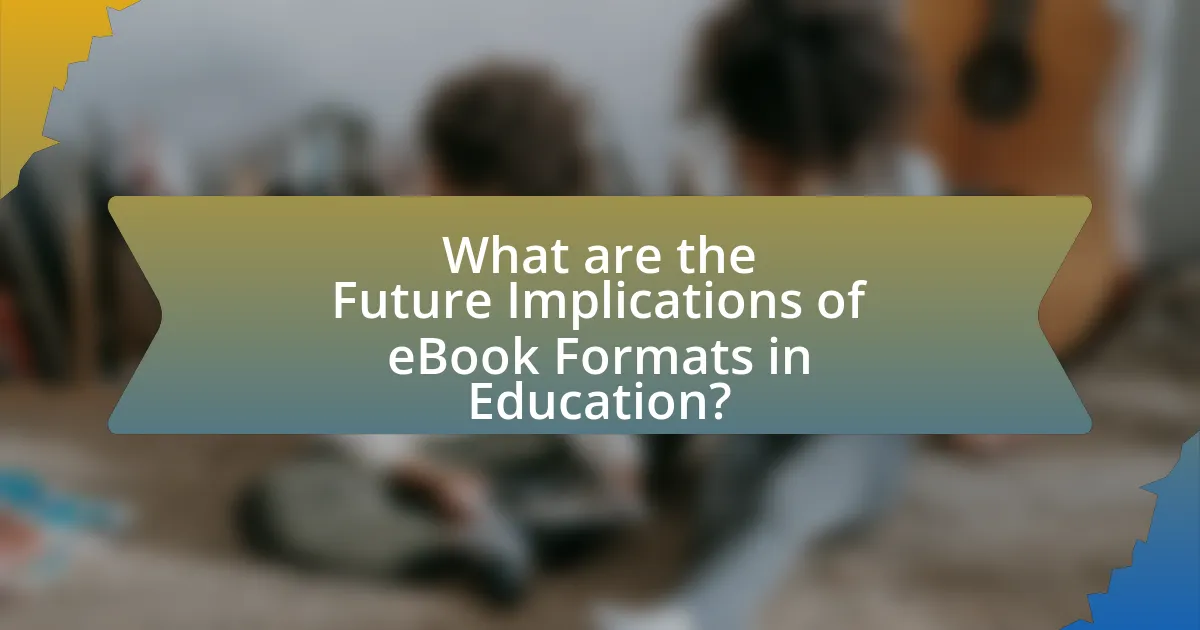
What are the Future Implications of eBook Formats in Education?
The future implications of eBook formats in education include enhanced accessibility, personalized learning experiences, and cost-effectiveness. eBooks can be accessed on various devices, allowing students with disabilities to utilize features like text-to-speech and adjustable font sizes, thereby promoting inclusivity. Additionally, eBook platforms often incorporate interactive elements such as quizzes and multimedia, which cater to diverse learning styles and enable tailored educational experiences. A study by the National Center for Education Statistics found that digital learning resources can reduce educational costs by up to 30%, making eBooks a financially viable option for institutions. These factors collectively indicate that eBook formats will play a crucial role in shaping the future landscape of education.
How might eBook formats evolve to meet educational demands?
eBook formats may evolve to meet educational demands by incorporating interactive features, adaptive learning technologies, and enhanced multimedia content. These advancements will facilitate personalized learning experiences, allowing students to engage with material in diverse ways. For instance, research indicates that interactive eBooks can improve comprehension and retention rates, as evidenced by a study published in the Journal of Educational Psychology, which found that students using interactive eBooks scored 20% higher on comprehension tests compared to those using traditional texts. Additionally, the integration of analytics within eBook platforms can provide educators with insights into student progress, enabling targeted interventions.
What features will future eBook formats need to support learning?
Future eBook formats will need to support interactive features, adaptive learning capabilities, and multimedia integration to enhance learning. Interactive features, such as quizzes and annotations, allow learners to engage actively with the content, promoting retention and understanding. Adaptive learning capabilities enable personalized experiences by adjusting the material based on individual progress and comprehension levels, which has been shown to improve learning outcomes. Multimedia integration, including videos, audio, and interactive simulations, caters to diverse learning styles and can make complex concepts more accessible. Research indicates that multimedia learning can increase retention rates by up to 60%, highlighting the importance of these features in future eBook formats.
How can educators prepare for changes in eBook technology?
Educators can prepare for changes in eBook technology by staying informed about emerging trends and advancements in digital publishing. This involves regularly attending professional development workshops, subscribing to relevant educational technology journals, and participating in online forums focused on eBooks and digital learning. Research indicates that educators who engage with new technologies can enhance their teaching methods and improve student engagement, as seen in studies like “The Impact of Digital Textbooks on Student Learning” published in the Journal of Educational Technology. By actively seeking out training and resources, educators can effectively integrate new eBook formats into their curricula, ensuring they meet the evolving needs of their students.
What best practices should educators follow when using eBooks?
Educators should prioritize accessibility, engagement, and integration when using eBooks in their teaching. Ensuring that eBooks are accessible to all students, including those with disabilities, is crucial; this can be achieved by selecting eBooks that comply with accessibility standards such as WCAG. Engaging students through interactive features, such as embedded quizzes and multimedia elements, enhances learning experiences and retention. Furthermore, integrating eBooks into the curriculum effectively requires aligning them with learning objectives and providing guidance on how to use them, which has been shown to improve student outcomes. Research indicates that students who engage with interactive eBooks demonstrate higher levels of comprehension and motivation compared to traditional texts.
How can teachers effectively integrate eBooks into their lesson plans?
Teachers can effectively integrate eBooks into their lesson plans by aligning eBook content with curriculum objectives and utilizing interactive features to enhance engagement. By selecting eBooks that complement specific learning goals, educators can provide students with diverse resources that cater to different learning styles. For instance, eBooks often include multimedia elements such as videos, quizzes, and hyperlinks, which can facilitate deeper understanding and retention of material. Research indicates that the use of interactive eBooks can improve student motivation and learning outcomes, as evidenced by a study published in the Journal of Educational Technology & Society, which found that students using interactive eBooks scored higher on assessments compared to those using traditional texts.
What resources are available for educators to enhance eBook usage?
Educators can enhance eBook usage through various resources such as digital libraries, eBook platforms, and instructional guides. Digital libraries like Project Gutenberg and Open Library provide access to a vast collection of free eBooks, allowing educators to incorporate diverse reading materials into their curriculum. eBook platforms such as Kindle, Apple Books, and Google Play Books offer tools for annotation, highlighting, and sharing, which can facilitate interactive learning experiences. Additionally, instructional guides and professional development courses focused on integrating eBooks into teaching practices are available from organizations like the International Society for Technology in Education (ISTE) and the American Library Association (ALA), which provide strategies and best practices for effective eBook usage in educational settings.









